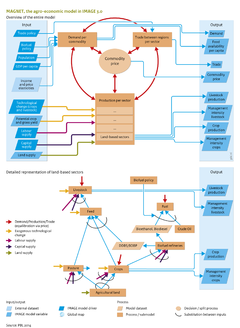Agricultural economy: Difference between revisions
Jump to navigation
Jump to search
No edit summary |
m (Text replace - "Trade;" to "Trade (crop and lifestock)") |
||
| Line 7: | Line 7: | ||
|InputVar=Population; GDP per capita; Capital supply; Labor supply; Trade policy; Biofuel policy | |InputVar=Population; GDP per capita; Capital supply; Labor supply; Trade policy; Biofuel policy | ||
; Land supply; Change in potential crop and grass yield; Technological change (crops and livestock); Income and price elasticities of agricultural commodities demand; | ; Land supply; Change in potential crop and grass yield; Technological change (crops and livestock); Income and price elasticities of agricultural commodities demand; | ||
|OutputVar=Crop production; Management intensity crops; Management intensity livestock; Food availability per capita; Commodity price; Livestock production; Trade | |OutputVar=Crop production; Management intensity crops; Management intensity livestock; Food availability per capita; Commodity price; Livestock production; Trade (crop and lifestock) Demand (crop and lifestock); | ||
|Description=Expansion of agricultural land is one of the most important and visible alterations to the natural environment, leading to greenhouse gas emissions, losses in biodiversity and ecosystem services, and nutrient imbalances. It is driven by the production of food, feed, fibres and other products, such as bio-energy and timber, resulting from trade and the domestic demand for these products. As in the past, agricultural production is expected to increase strongly, also in the coming decades, as a result of a growing world population and higher per-capita consumption. Despite the expected increasing agricultural yields and efficiency improvements, this will still lead to an increasing demand for agricultural land. To reduce the associated environmental impacts, efforts to further increase agricultural yields and reduce deforestation are required urgently, but currently lack sufficient political support. | |Description=Expansion of agricultural land is one of the most important and visible alterations to the natural environment, leading to greenhouse gas emissions, losses in biodiversity and ecosystem services, and nutrient imbalances. It is driven by the production of food, feed, fibres and other products, such as bio-energy and timber, resulting from trade and the domestic demand for these products. As in the past, agricultural production is expected to increase strongly, also in the coming decades, as a result of a growing world population and higher per-capita consumption. Despite the expected increasing agricultural yields and efficiency improvements, this will still lead to an increasing demand for agricultural land. To reduce the associated environmental impacts, efforts to further increase agricultural yields and reduce deforestation are required urgently, but currently lack sufficient political support. | ||
Within the IMAGE framework, future development of the agricultural economy is calculated by the agro-economic model [[MAGNET model|MAGNET]] (formerly LEITAP) ([[Woltjer et al., 2011]]). MAGNET, a computable general equilibrium ([[CGE]]) model, is connected via a soft linkage to the core model of IMAGE. Demographic development and increasing income lead to a change in the demand for all commodities including those in agriculture. On the supply side, agricultural production responds to this changing demand, also taking into account prices of production factors, resource availability and technological progress. In the model, agricultural production is delivering to over domestic uses and to foreign regions via international trade, depending on historical trade balances, competitiveness (relative price developments), transport costs and trade policies. The MAGNET model uses information from IMAGE on land availability and suitability, and on the change in crop yields due to climate change and agricultural expansion on inhomogeneous land areas. IMAGE, in turn, uses production and endogenous yield (management factor) results from MAGNET to calculate spatially explicit land-use change, and the environmental impacts on carbon, nutrient and water cycles, biodiversity, and climate. Although MAGNET is the standard agro-economic model coupled to IMAGE, it is possible to use other models, coupled in a similar way via soft-linkage. For example, the IMPACT model has been used together with IMAGE in the Millennium Ecosystem Assessment project ([[Carpenter et al., 2006]]), and in a PBL study on protein supply, allowing for a comparison with MAGNET ([[Stehfest et al., 2013]]). | Within the IMAGE framework, future development of the agricultural economy is calculated by the agro-economic model [[MAGNET model|MAGNET]] (formerly LEITAP) ([[Woltjer et al., 2011]]). MAGNET, a computable general equilibrium ([[CGE]]) model, is connected via a soft linkage to the core model of IMAGE. Demographic development and increasing income lead to a change in the demand for all commodities including those in agriculture. On the supply side, agricultural production responds to this changing demand, also taking into account prices of production factors, resource availability and technological progress. In the model, agricultural production is delivering to over domestic uses and to foreign regions via international trade, depending on historical trade balances, competitiveness (relative price developments), transport costs and trade policies. The MAGNET model uses information from IMAGE on land availability and suitability, and on the change in crop yields due to climate change and agricultural expansion on inhomogeneous land areas. IMAGE, in turn, uses production and endogenous yield (management factor) results from MAGNET to calculate spatially explicit land-use change, and the environmental impacts on carbon, nutrient and water cycles, biodiversity, and climate. Although MAGNET is the standard agro-economic model coupled to IMAGE, it is possible to use other models, coupled in a similar way via soft-linkage. For example, the IMPACT model has been used together with IMAGE in the Millennium Ecosystem Assessment project ([[Carpenter et al., 2006]]), and in a PBL study on protein supply, allowing for a comparison with MAGNET ([[Stehfest et al., 2013]]). | ||
Revision as of 10:21, 30 January 2014
Parts of Agricultural economy
| Component is implemented in: |
|
| Related IMAGE components |
| Projects/Applications |
| Key publications |
| References |
Key policy issues
- What is the area of cropland and grassland required to support future food demand?
- What are the policy options to reduce agricultural land use and to safeguard global biodiversity, while ensuring food security?
- How can the implications of biofuels for land use and greenhouse gases be managed sustainably?
